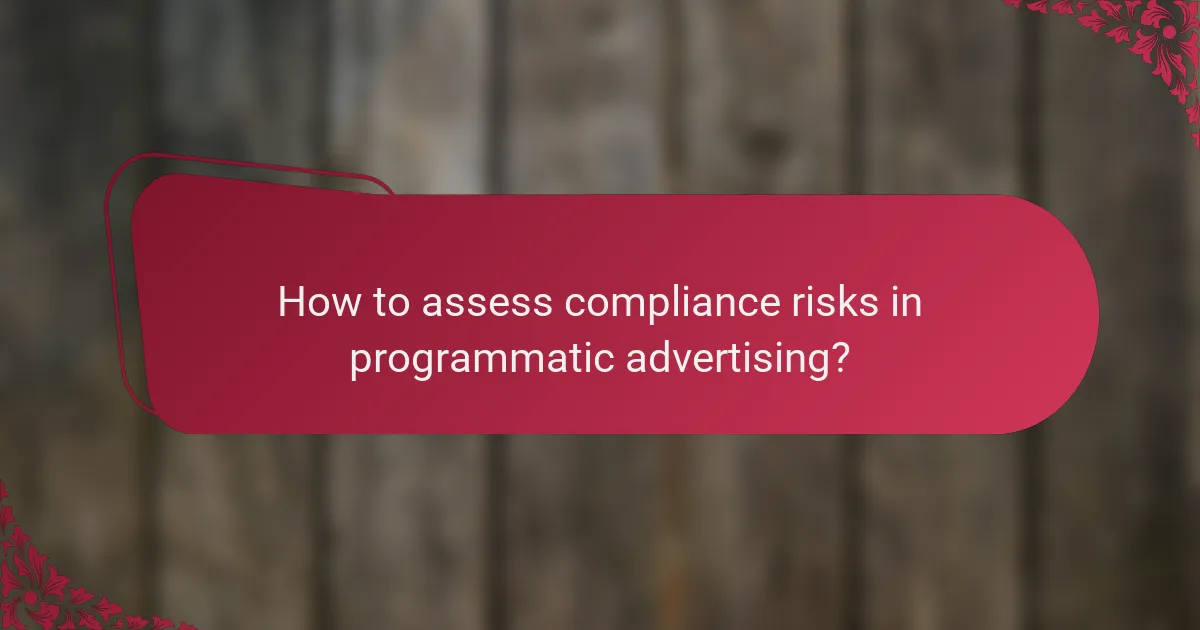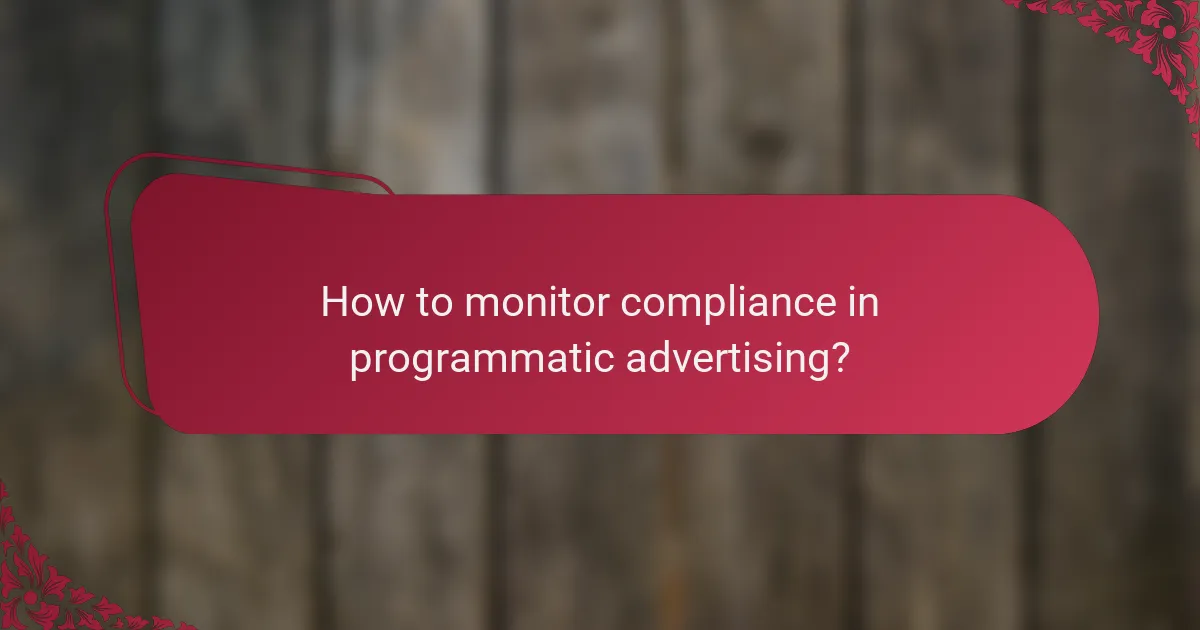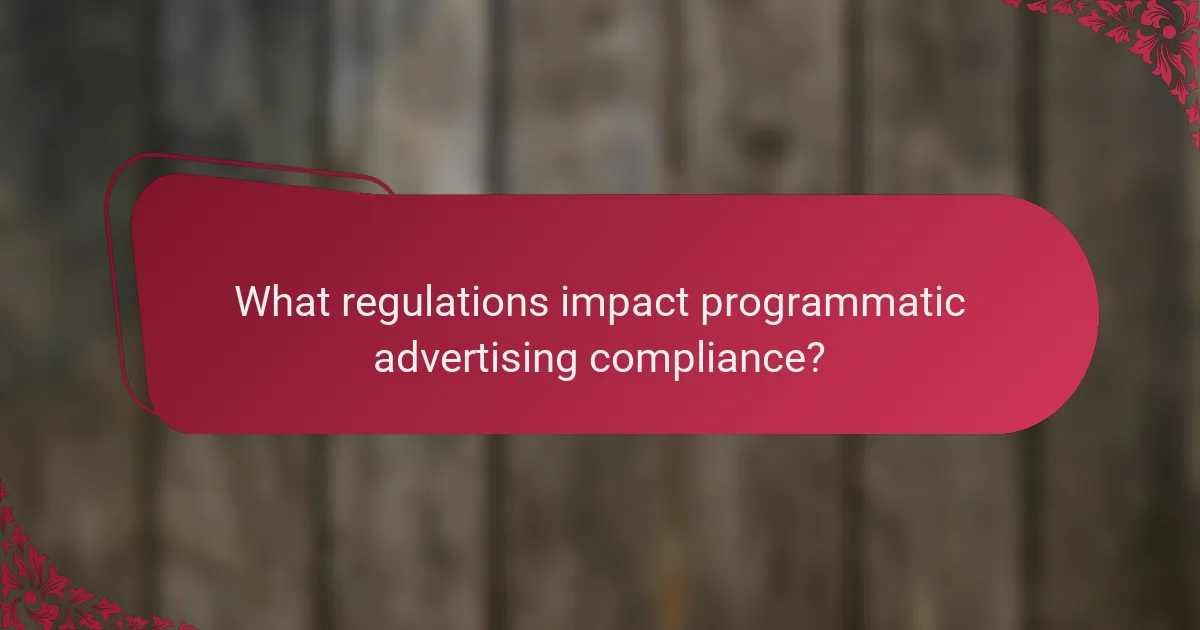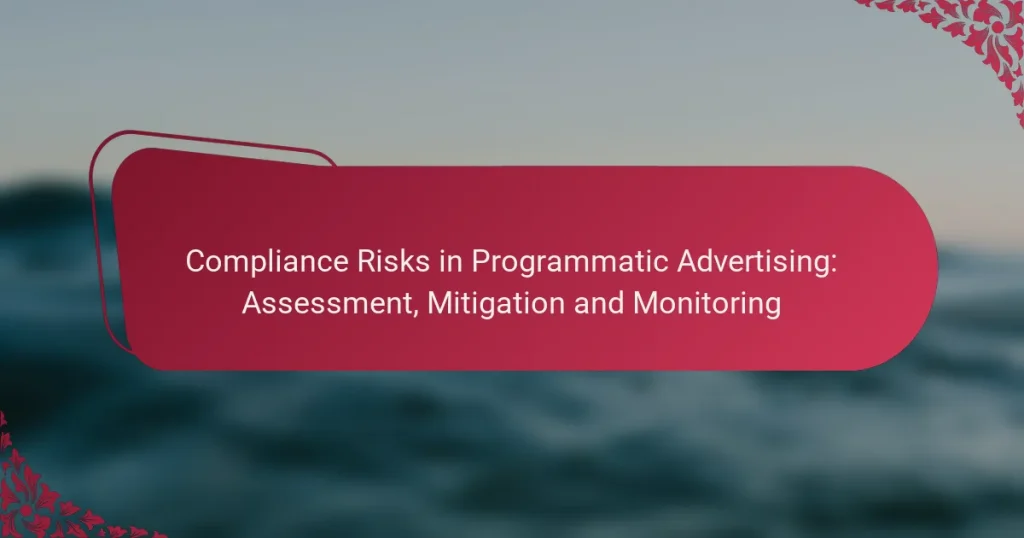Compliance risks in programmatic advertising pose significant challenges, including data privacy violations, fraudulent ad placements, and regulatory non-compliance. Proper assessment and mitigation of these risks are essential to protect organizations from financial penalties and reputational damage. By implementing robust data governance and adhering to industry best practices, businesses can navigate the complex regulatory landscape effectively.

What are the compliance risks in programmatic advertising?
Compliance risks in programmatic advertising include potential violations of data privacy, fraudulent ad placements, brand safety issues, and regulatory non-compliance. These risks can lead to financial penalties, reputational damage, and loss of consumer trust if not properly managed.
Data privacy violations
Data privacy violations occur when advertisers fail to protect user data or misuse personal information. With regulations like GDPR in Europe and CCPA in California, companies must ensure they obtain explicit consent from users before collecting or processing their data.
To mitigate these risks, implement robust data management practices. Regularly audit data collection methods, ensure transparency in data usage, and provide users with clear options to opt-out of data sharing.
Fraudulent ad placements
Fraudulent ad placements involve deceptive practices where ads are placed on illegitimate sites or in front of non-human traffic. This can lead to wasted ad spend and ineffective campaigns.
To combat this, use verification tools to monitor where ads are displayed. Partner with reputable ad networks and regularly review performance metrics to identify any anomalies that may indicate fraud.
Brand safety concerns
Brand safety concerns arise when ads appear alongside inappropriate or harmful content, potentially damaging a brand’s reputation. Advertisers must be vigilant about the environments in which their ads are placed.
Establish clear brand safety guidelines and utilize technology that allows for real-time monitoring of ad placements. Consider using whitelists and blacklists to control where your ads can appear.
Regulatory non-compliance
Regulatory non-compliance refers to failing to adhere to advertising laws and regulations, which can result in significant fines and legal issues. Different regions have varying requirements, making it essential to stay informed about local laws.
To ensure compliance, regularly review and update your advertising practices according to the latest regulations. Engage legal counsel to help navigate complex compliance landscapes and conduct training for your team on relevant laws and standards.

How to assess compliance risks in programmatic advertising?
Assessing compliance risks in programmatic advertising involves identifying potential legal and regulatory issues that could arise during ad placements. This process is crucial for ensuring that advertising practices align with applicable laws and industry standards.
Conducting risk assessments
Conducting risk assessments requires a systematic evaluation of your programmatic advertising practices. Start by identifying all relevant regulations, such as GDPR in Europe or CCPA in California, and assess how your ad strategies align with these laws.
Consider creating a risk matrix that categorizes risks by likelihood and impact. This will help prioritize which compliance risks need immediate attention and which can be monitored over time.
Utilizing compliance checklists
Utilizing compliance checklists can streamline the assessment process by ensuring that all necessary compliance areas are covered. Develop a checklist that includes key compliance areas such as data privacy, ad content regulations, and vendor compliance.
Regularly update the checklist to reflect changes in regulations or industry best practices. This proactive approach helps maintain compliance and reduces the likelihood of overlooking critical requirements.
Engaging third-party auditors
Engaging third-party auditors provides an objective evaluation of your compliance risks in programmatic advertising. These auditors can offer insights into areas of non-compliance that internal teams may overlook.
Choose auditors with experience in digital advertising regulations and a solid understanding of your specific market. Their independent assessments can help validate your compliance efforts and identify areas for improvement.

What are effective mitigation strategies for compliance risks?
Effective mitigation strategies for compliance risks in programmatic advertising include implementing robust data governance, adopting industry best practices, and training staff on compliance. These strategies help organizations navigate the complex regulatory landscape while minimizing potential legal and financial repercussions.
Implementing robust data governance
Robust data governance involves establishing clear policies and procedures for data collection, storage, and usage. Organizations should define data ownership, access controls, and data lifecycle management to ensure compliance with regulations such as GDPR or CCPA.
Key steps include conducting regular audits of data practices, maintaining accurate records of data processing activities, and ensuring transparency with users about how their data is used. This proactive approach can significantly reduce compliance risks.
Adopting industry best practices
Adopting industry best practices involves aligning with established standards and guidelines within the programmatic advertising ecosystem. This includes following frameworks like the Digital Advertising Alliance (DAA) guidelines and the Interactive Advertising Bureau (IAB) standards.
Organizations should regularly review and update their practices to reflect changes in technology and regulations. Collaborating with industry groups can provide valuable insights and resources to stay compliant while optimizing advertising strategies.
Training staff on compliance
Training staff on compliance is crucial for fostering a culture of accountability and awareness regarding regulatory requirements. Regular training sessions should cover relevant laws, internal policies, and the implications of non-compliance.
Consider implementing a comprehensive onboarding program for new employees and ongoing refresher courses for existing staff. Utilizing real-world scenarios and case studies can enhance understanding and retention of compliance principles.

How to monitor compliance in programmatic advertising?
Monitoring compliance in programmatic advertising involves systematically tracking adherence to legal and ethical standards throughout the advertising process. This ensures that campaigns align with regulations and best practices, minimizing risks associated with data privacy and consumer protection.
Using compliance monitoring tools
Compliance monitoring tools are essential for automating the tracking of advertising activities against regulatory standards. These tools can analyze data flows, flag potential violations, and provide real-time insights into compliance status.
Examples of such tools include platforms that offer features like data encryption, user consent management, and audit trails. Selecting tools that integrate seamlessly with existing advertising technologies can enhance efficiency and reduce manual oversight.
Regular audits and reviews
Conducting regular audits and reviews is crucial for maintaining compliance in programmatic advertising. These audits should assess both the technical aspects of ad delivery and the adherence to privacy regulations, such as GDPR or CCPA.
Establish a schedule for audits, ideally quarterly or biannually, to ensure ongoing compliance. During audits, review campaign data, consent records, and vendor contracts to identify any discrepancies or areas for improvement.
Establishing reporting mechanisms
Effective reporting mechanisms facilitate transparency and accountability in programmatic advertising. Create clear channels for reporting compliance issues, ensuring that all stakeholders can easily communicate concerns or violations.
Consider implementing a centralized reporting system that allows for tracking incidents and resolutions. Regularly review these reports to identify patterns and address systemic issues, thereby strengthening overall compliance efforts.

What regulations impact programmatic advertising compliance?
Programmatic advertising compliance is primarily influenced by regulations that govern data privacy and consumer protection. Key regulations include the General Data Protection Regulation (GDPR) in Europe, the California Consumer Privacy Act (CCPA) in California, and guidelines from the Federal Trade Commission (FTC) in the USA.
GDPR in Europe
The GDPR sets strict rules for data protection and privacy in the European Union, impacting how programmatic advertising collects and uses personal data. Advertisers must obtain explicit consent from users before processing their data and provide clear information about how their data will be used.
Failure to comply with GDPR can result in significant fines, often reaching up to 4% of a company’s annual global turnover. Advertisers should implement robust consent management systems and ensure transparency in their data practices to mitigate compliance risks.
CCPA in California
The CCPA grants California residents rights regarding their personal information, including the right to know what data is collected and the ability to opt-out of its sale. Programmatic advertisers must provide clear notices and options for consumers to manage their data preferences.
Non-compliance with CCPA can lead to penalties of up to $7,500 per violation. Businesses should regularly review their data handling practices and ensure they have mechanisms in place for consumer requests to avoid potential liabilities.
FTC guidelines in the USA
The FTC provides guidelines to ensure that advertising is truthful and not misleading, which applies to programmatic advertising as well. Advertisers must disclose material connections and avoid deceptive practices in targeting and messaging.
To comply with FTC guidelines, businesses should maintain transparency in their advertising strategies and ensure that any claims made in ads are substantiated. Regular audits of advertising content and practices can help identify and rectify potential compliance issues before they escalate.

How does technology influence compliance in programmatic advertising?
Technology plays a crucial role in ensuring compliance in programmatic advertising by automating processes and enhancing monitoring capabilities. With advanced tools, advertisers can better manage risks associated with data privacy, ad fraud, and regulatory adherence.
Role of AI in risk detection
Artificial Intelligence (AI) significantly enhances risk detection in programmatic advertising by analyzing vast amounts of data in real-time. AI algorithms can identify patterns indicative of non-compliance or fraudulent activities, allowing for swift action to mitigate risks.
For example, AI can flag unusual spending patterns or discrepancies in user data that may suggest a breach of privacy regulations. Implementing AI-driven solutions can lead to a reduction in compliance-related issues by up to 30% in some cases.
Blockchain for transparency
Blockchain technology offers a decentralized and immutable ledger that enhances transparency in programmatic advertising. By recording every transaction, blockchain provides a clear audit trail, making it easier to verify compliance with industry standards and regulations.
Using blockchain can help advertisers ensure that their ad placements are legitimate and that data usage complies with privacy laws. This technology can also reduce disputes between parties by providing verifiable proof of transactions, thus fostering trust in the advertising ecosystem.


